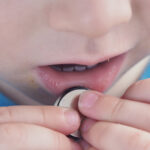Get a jump on potential eye conditions by having your child regularly tested

It can be surprising to learn your child has an eye condition. Children don’t always outwardly show symptoms of nearsightedness, a lazy eye, or another vision problem.
That’s because children are adaptive. If one of their eyes doesn’t function well, they learn to adjust with the other one, according to Dr. Ryan Gise, an ophthalmologist in Boston Children’s Department of Ophthalmology. Some children will tell a parent something’s wrong, but others will adapt without even realizing they have a condition — illustrating why parents should have their child’s eyes regularly tested.
The key stage of neurodevelopment, from birth to age 8, is particularly important for diagnosing and treating eye conditions, Dr. Gise says. At those ages, eyeglasses or an eye patch can correct many conditions and possibly prevent lasting ocular-neurodevelopment issues. “Early detection and treatment will often lead to better vision,” he says.
Birth until 8 is a critical development period
A child learns how to see in the first five years of life. Neurodevelopment pathways between the eyes and brain form, allowing the brain to “understand” the objects that the eyes see. For that matter, critical visual development continues until age 8.
Diagnosing eye conditions at this stage can make a significant difference in how a child will see throughout life, Dr. Gise says. “This is a critical period where we can help foster development that is life-changing. If the brain eventually doesn’t have 20/20 vision to work with, the pathways essentially shut off.”
A simple fix with eyeglasses or an eye patch
Fortunately, clinicians can find a proper solution for many eye conditions, Dr. Gise says. Blurriness and squinting from astigmatism or the misalignment of the eyes from strabismus are just some of the conditions that may be addressed with a pair of eyeglasses or part-time use of an eye patch.
Some parents worry their child won’t regularly put on their eyeglasses because they’ll feel socially awkward around peers who don’t wear them. But Dr. Gise believes the social stigma of eyeglasses has lessened over the years because more children are being diagnosed with eye conditions and are wearing eyeglasses. For many children, eyeglasses are stylish and maybe even cool.
Eyeglasses will resolve many conditions, but sometimes an eye patch is needed as a secondary measure for lazy eye (amblyopia). An eye patch over the child’s stronger eye will force the weaker eye to build up strength and reopen pathways in the brain. Dr. Gise tells children and their parents it’s like asking a tennis player to increase exercises for the arm that doesn’t swing a racquet.
Consistent eye screening should start at birth
The American Academy of Ophthalmology and the American Academy of Pediatrics recommend that, starting as newborns, children should have their eyes checked through vision screening during checkups by their pediatrician. The type of vision screening varies depending on a child’s age but it is essentially a check of each eye’s health and vision.
Dr. Gise says it’s common for siblings in a family to need eyeglasses or other treatment for an eye condition. Genetics is a factor in many eye conditions. Also, eyeglasses and a patch won’t treat all conditions. Sometimes surgery is necessary. But many times, if a condition is caught early in life, the simpler solution of eyewear may be sufficient treatment.
“If we catch these conditions early, you can see the improvement in visual behavior,” Dr. Gise says. “It really does make a difference.”
Learn more about the Department of Ophthalmology.
Related Posts :
-

Tiny, shiny, and dangerous: What families should know about button batteries
Button batteries may be bright, shiny, and eye catching, but they also have a dark side — especially for kids. Look ...
-

Social and emotional health in high school
Sarauna Moore has a unique perspective on students’ emotional and behavioral health. As part of the Boston Children’s Hospital ...
-

Babies and screen time: New research calls for caution
If you’re a parent, you’ve probably been there. You have a baby howling for attention, but you need ...
-

What every family should know about RSV
To help keep your family safe and informed about respiratory syncytial virus (RSV), we spoke to Dr. Kathleen Conroy, Clinical ...





